🏖️ To the south of Toulon, the Saint-Mandrier peninsula is a small, unspoilt paradise whose dream beaches can be discovered along the sentier du Littoral. Our itinerary begins in the picturesque fishing village of Saint-Mandrier-sur-Mer. We'll take the afternoon to explore the area before heading to the port at the end of the afternoon: that's it, it's time to set sail! We boarded a magnificent catamaran and sailed for around two hours, under the setting sun, towards the Giens peninsula.
"On the deserted beach, shellfish and crustaceans". At the mere thought of a holiday on the Côte d'Azur, you start singing Brigitte Bardot's La Madrague. And rightly so, as the song is a tribute to life on the Mediterranean. More than fifty years on, the Côte d'Azur's reputation has not changed: with its turquoise waters, the song of the cicadas and its charming villages, it's the stuff of dreams. As soon as the fine weather arrives, many tourists head here to enjoy the sumptuous seaside setting. The region offers a breathtaking quality of life and scenery, which we suggest you explore by sea to broaden your horizons. Hire your own boat or join an all-inclusive catamaran cruise, and get on the water straight away!
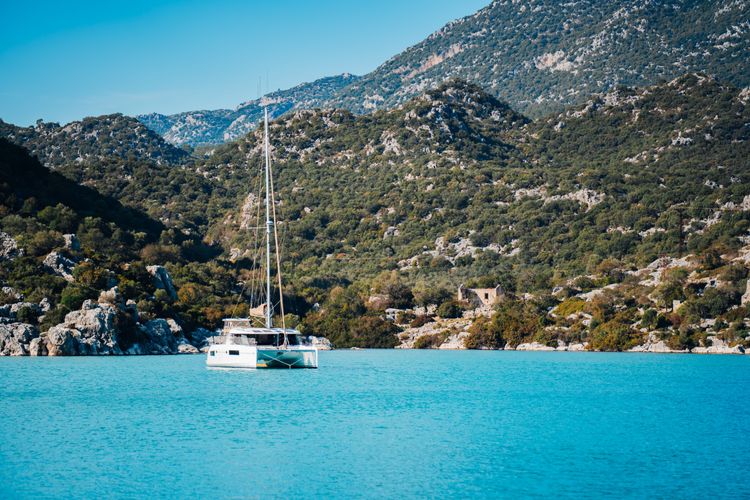
A catamaran in the Mediterranean.
- © vankey / Shutterstock- Day 1: Saint-Mandrier-sur-Mer to the Giens peninsula
- Day 2: Head for Ramatuelle via Cap Bénat and the Cavalière cove
- Day 3: Do you, do you, do you Saint-Tropez?
- Day 4: En route to the Lérins Islands via the Agay roadstead
- Day 5: Discovering the Lérins Islands
- Day 6: Day at sea to the Hyères islands
- Day 7: Visit to Port-Cros and Porquerolles
- Day 8: Return to Toulon
Day 1: Saint-Mandrier-sur-Mer to the Giens peninsula
 Côte d'Azur
Côte d'Azur
Book your one-week cruise on the Côte d'Azur!
Catlante Catamarans offers one-week all-inclusive catamaran cruises to discover the beauty of the Côte d'Azur.🐚 🦩 A genuine geological curiosity, the Giens peninsula is proof that nature is full of surprises. Linked to the mainland by two very distinct five-kilometre-long sandy inlets - also known as a double tombolo - this peninsula is unique in France. It is dotted with idyllic coves, heavenly beaches, dozens of caves, charming little inlets and delightful harbours nestling between the rocks. From the boat, you can enjoy a privileged view. What's more, this geological beauty is home to an ornithological reserve populated by pink flamingos.
Day 2: Head for Ramatuelle via Cap Bénat and the Cavalière cove
⛵ The view of the Giens peninsula when we wake up is impressive, and we take advantage of the fact that we're up early to go for a morning stroll on the beach before setting off again. The boat then skirts Cap Bénat, a veritable natural jewel that promises a wonderful maritime escapade. From the boat, you can explore this rocky point overlooking the sea, where Aleppo pines and cork oaks grow side by side. You will then arrive at the cove of Cavalière, a long white sandy beach with a magnificent panorama of the Ile du Levant, where you will spend the afternoon before returning to Ramatuelle in the evening.

The Ramatuelle coastline.
- © AWP76 / Shutterstock🏝️ Just a few kilometres from Saint-Tropez, Ramatuelle has nothing to envy its famous neighbour. There are some magnificent, somewhat secret beaches and coves that only a few seasoned sailors know about. But'the place to be' is undoubtedly Pampelonne beach, the origin of the 'Tropezian myth'. If you're passing through Ramatuelle, it's impossible not to immortalise the moment: you'll have to take a dip in the turquoise water.
Day 3: Do you, do you, do you Saint-Tropez?
🛥️ We spend the morning in Ramatuelle, enjoying the beach at Pampelonne, then head for Saint-Tropez, the most legendary village on the Côte d'Azur. This small village has fewer than 4,500 inhabitants, yet it is one of the most famous in the world. A favourite holiday destination for the stars and the jet set, why is it so popular? Perhaps it's due to the charm of its narrow streets, its beaches and its harbour, from which magnificent yachts depart, their owners bathed in luxury...
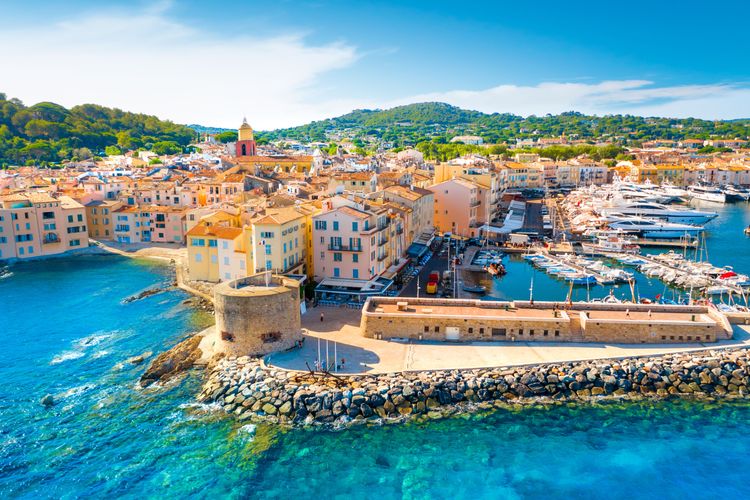
The port of Saint-Tropez.
- © proslgn / Shutterstock🎭 In Saint-Trop', art also plays a key role: since Guy de Maupassant and Paul Signac, many writers, as well as painters and film-makers, have passed through here. This artistic craze is still alive and well, as evidenced by the many art galleries hidden away in the narrow streets. You can also visit a number of museums retracing the city's history or enjoy the wild nightlife that reveals itself once the sun goes down. Whether you're into art, water sports, shopping or just lazing around, you've got to love Saint-Tropez!
Day 4: En route to the Lérins Islands via the Agay roadstead
🌊 Waking up in the Bay of Saint-Tropez is most pleasant, but we don't linger too long and head for the Agay roadstead, between the Pointe de la Baumette and Cap Dramont. Here you'll find a delightful beach, a stretch of fine sand in shallow waters, with the summit of Rastel and the red rocks of the Esterel massif in the background. Saint Exupéry, Maupassant, Donnay and many other artists have been inspired by the Agay roadstead, one of the most beautiful in the region.
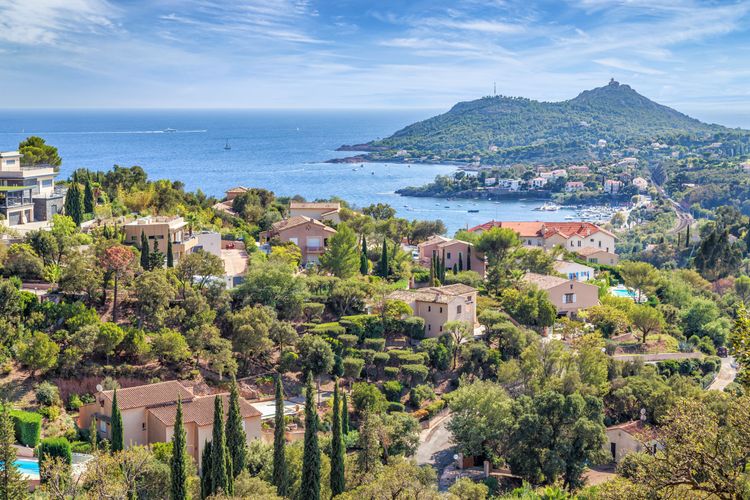
The town and bay of Agay.
- © Telly / Shutterstock⛰️ For the rest of the day, the route runs along the Esterel massif towards Cannes. The red colour of its peculiar relief contrasts with the blue of the Mediterranean into which dizzying coves plunge, offering a spectacle without name. Its 32,000 hectares of rock dotted with vegetation cover the south-east of the Var, as well as a small part of the Alpes-Maritimes. Turbulentvolcanic activity and erosion have shaped the steep, jagged relief of the Esterel massif. We'll be spending the night near the Lérins islands, which we can't wait to discover the next day!
Day 5: Discovering the Lérins Islands
🦀 TheLérins archipelago comprises the island of Sainte-Marguerite, the largest, and Saint-Honorat, its smaller sister. On landing on Sainte-Marguerite, you're immediately enchanted by thesmell of pine and eucalyptus trees. It is covered by 152 hectares of forest with a wide variety of flora and fauna: the Batéguier pond alone is home to more than 130 species of bird! Both wild and heavenly, this island is a veritable paradise despite a tragic piece of history: Le Masque de Fer, a famous 17th-century prisoner, spent 30 years in the prison wing of Fort Royal. This has now become a tourist attraction.
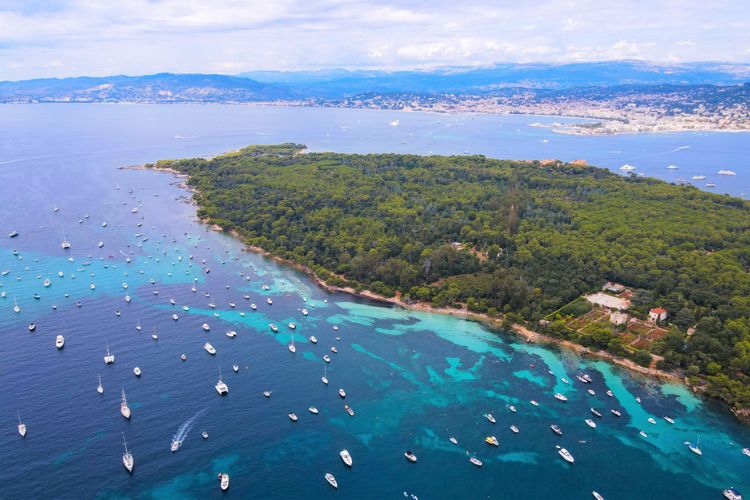
Boats on the shores of Ile Sainte-Marguerite.
- © AerialDronePics / Shutterstock⛪ With a surface area of 40 hectares, theisland of Saint-Honorat is smaller than Sainte-Marguerite but just as charming. A spiritual mecca, it is the ancestral home of the monks ofLérins Abbey. Today, around twenty of them live here. You can visit the fortified monastery free of charge. Take the pine-wooded paths leading down to the turquoise sea and wander through the island's lush gre enery and vineyards: a trip to Saint-Honorat placed under the sign of positivity and calm. 🌲
Day 6: Day at sea to the Hyères islands
🐬 Today, we set sail early for Hyères: it's off for six hours of sailing on the calm waters of the Mediterranean. The whole crew is keeping an eye out, as the area is known to be home to dolphins, whales and many other species of marine mammals that sometimes come to play in the waves created by the boats.
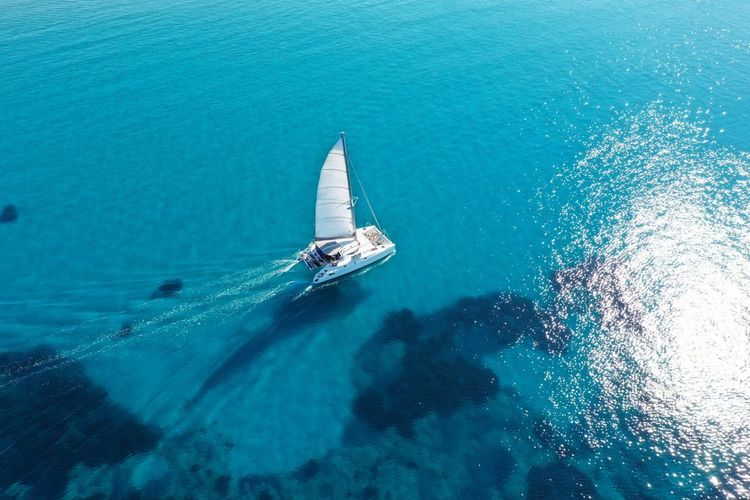
A catamaran on the Mediterranean.
- © Evangelos Anagnostou / Shutterstock🌅 We take a break at the splendid Pampelonne beach for lunch and a swim, then set course for the Golden Isles, a group of four islands and a few islets including Porquerolles, Bagaud, Rocher du Rascas, Gabinière, Port-Cros, Le Levant and Petit Langoustier. You reach them at dusk, when the last rays of sunlight are reflected on the foam, and you can't help but be captivated by the beauty of the landscape.
Day 7: Visit to Port-Cros and Porquerolles
⛰️ As lovers of secret paradises and unspoilt nature, we really enjoyed discovering the island of Port-Cros. This is the wildest and most mountainous of the Hyères islands. It is sparsely inhabited and has been protected by a National Park since 1963. Its seabed is sublime, as are its sun-drenched beaches. With 30 kilometres of hiking trails, visitors will discover sumptuous landscapes, contrasted by the blue of the sea and the green of the lush vegetation.
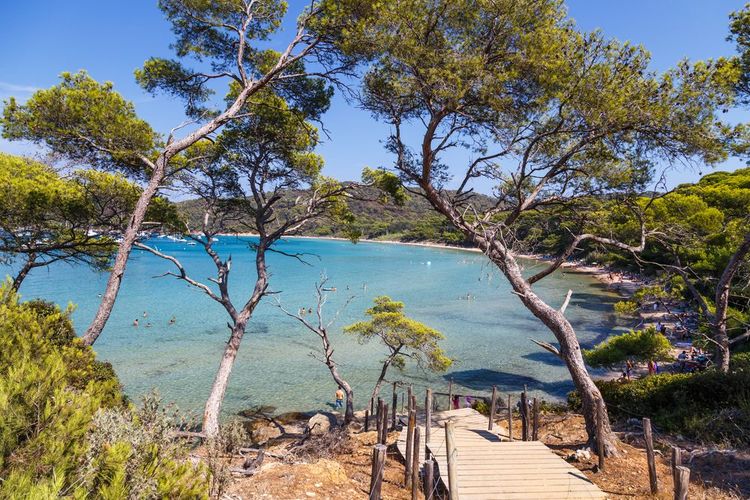
Pretty beach on the island of Porquerolles.
- © Telly / Nicolas Bryant🌊 But it's fair to say that the real star that captures the hearts of holidaymakers on the Côte d'Azur is none other than the island of Porquerolles. It's impossible not to fall in love with this natural jewel surrounded by turquoise waters. Nor can you fail to fall head over heels in front of these beaches covered in maritime pines, reminding us that we are indeed in the Mediterranean. The Provençal picture postcard doesn't stop there: hiking trails skirting little creeks, pine forests, historic forts and fields of vines. Porquerolles never ceases to amaze... 🥾
Day 8: Return to Toulon
🕑 We're leaving the Hyères islands fairly early to finish our journey where it began, near Saint-Mandrier. The return journey takes around two hours and offers a beautiful panorama of Toulon harbour, which is well worth a visit.
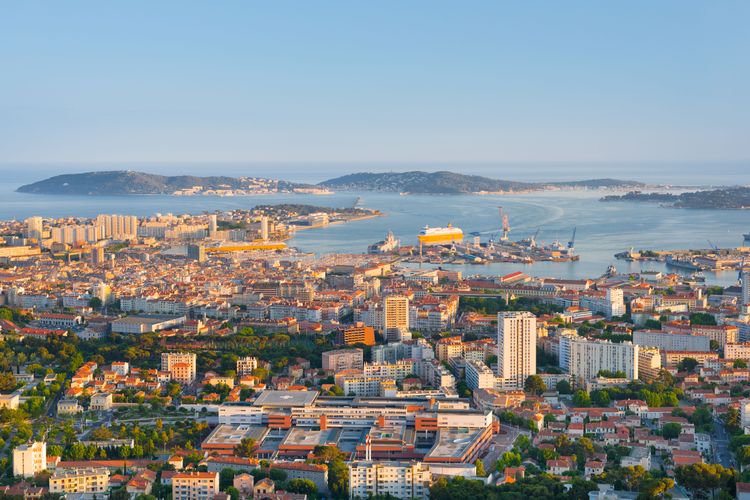
La ville de Toulon.
- © SergiyN / Nicolas Bryant🌊 Originally, Toulon was simply a wine-exporting port, but situated between the sea and the mountains, it boasts a host of tourist attractions. As well as being one of the sunniest places in France, the city boasts the most beautiful harbour in the country! With seven hectares of beaches, a lively city centre and plenty of sunshine, Toulon is one of the hottest spots on the Mediterranean coast. ⛰️






